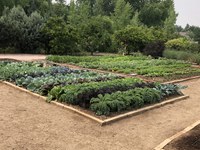Dakota Gardener: Fall is a Great Time to Test Your Garden Soil
(Click an image below to view a high-resolution image that can be downloaded)
By Esther E. McGinnis, Horticulturist
NDSU Extension
“Don’t call it dirt! Dirt is what you track into the house. Soil is the proper name of the material that anchors and holds water and nutrients for plants,” insisted my soils professor when I was in graduate school.
Soil has finally earned our respect and a proper name. We’ve come a long way since the Dust Bowl of the 1930s and realize how soil is precious and incredibly complex. However, we still have a lot to learn. Pinterest gardeners routinely think it is trendy to “improve” their soil by adding lots of organic matter, fertilizers, or dubious additives such as Epsom salts.
Does your garden soil really need all those additions? This is similar to a cook adding salt to the soup without tasting it. You need a baseline before making adjustments. Soil testing is the baseline you need before adding fertilizer, manure or other components.
Soil tests are best known for diagnosing nutrient deficiencies. If potassium levels are low, the soils testing lab will recommend potential potassium sources to alleviate the deficiency.
Lesser known is the importance of identifying high nutrient levels. Just like with the salt level in soup, you can add excessive levels of nutrients and amendments if you are not careful.
A lawn and garden soil test will provide information on organic matter, nitrogen, phosphorus, potassium, soil pH and soluble salt levels along with custom recommendations.
This information can save you money and labor. For example, if your soil has plenty of organic matter you can skip the laborious process of tilling compost into the soil.
Nationwide, soil testing labs are seeing more gardens that have excessive levels of phosphorus which can tie up important micronutrients such as iron. In the event of excessive phosphorus levels, a soil testing lab will recommend avoiding amendments high in phosphorus such as manure, 10-10-10 fertilizer and compost.
Soil testing can be done at any time of year but is best done before the soil freezes. A fall test allows gardeners to plan their fertilizer strategy before spring planting.
To get a representative soil sample, take soil from five or six locations in the garden. Using a shovel or hand trowel, extract a sample that is approximately 6 inches deep. Remove any leaves or organic matter from the top of the soil. Place these samples in a plastic bucket and stir thoroughly to create a composite sample. From this bucket, take at least 1 pint of soil and place it in a baggie.
If you have questions on the process of collecting a soil sample, please contact your friendly county NDSU Extension agent.
Before submitting the sample, make sure to provide background information such as whether the soil sample was taken from a vegetable garden, a flower garden, a lawn or other area. A vegetable garden will receive very different recommendations compared to a perennial flower garden.
North Dakota has two soil testing laboratories. For more information, please contact the following laboratories:
- NDSU Soil Testing Laboratory: https://www.ndsu.edu/snrs/services/soil_testing_lab/
- Agvise: https://www.agvise.com/
For more information about gardening, contact your county NDSU Extension agent. Find the Extension office for your county at https://www.ag.ndsu.edu/extension/directory/counties.
NDSU Agriculture Communication - October 12, 2021
Source: Esther McGinnis, 701-231-7971, esther.mcginnis@ndsu.edu
Editor: Kelli Anderson, 701-231-6136, kelli.c.anderson@ndsu.edu




